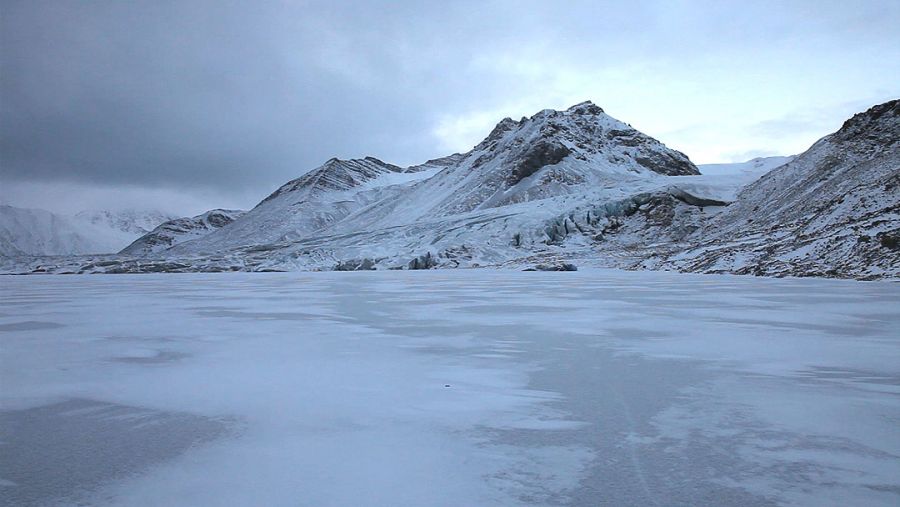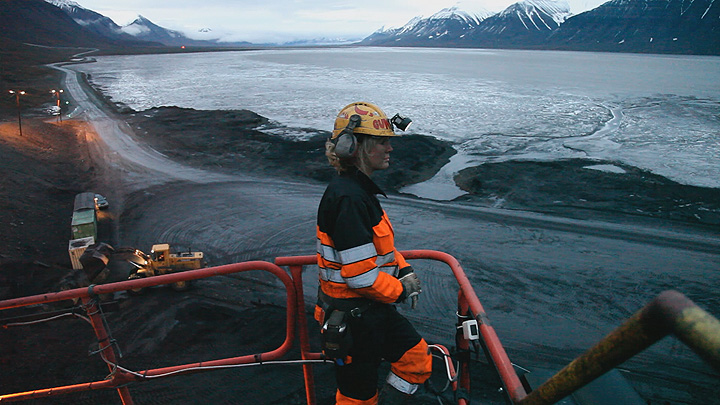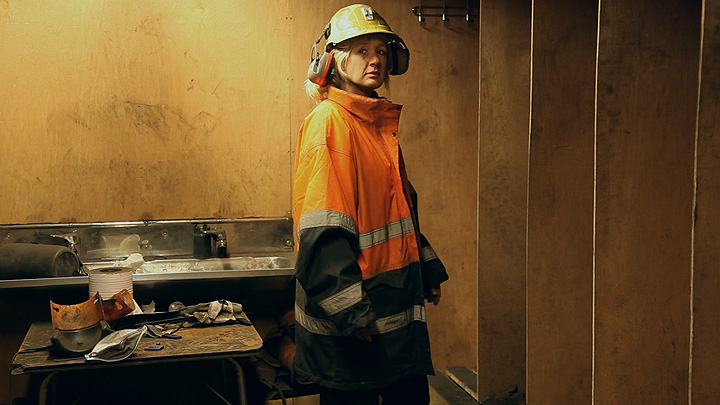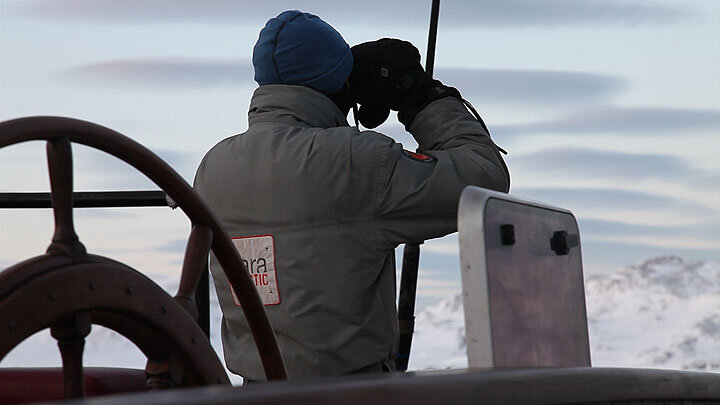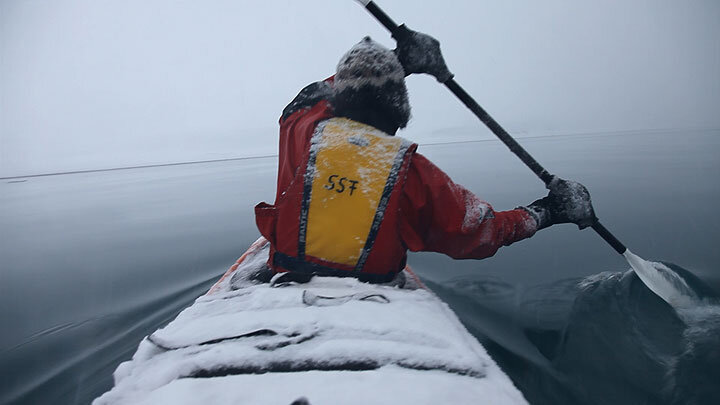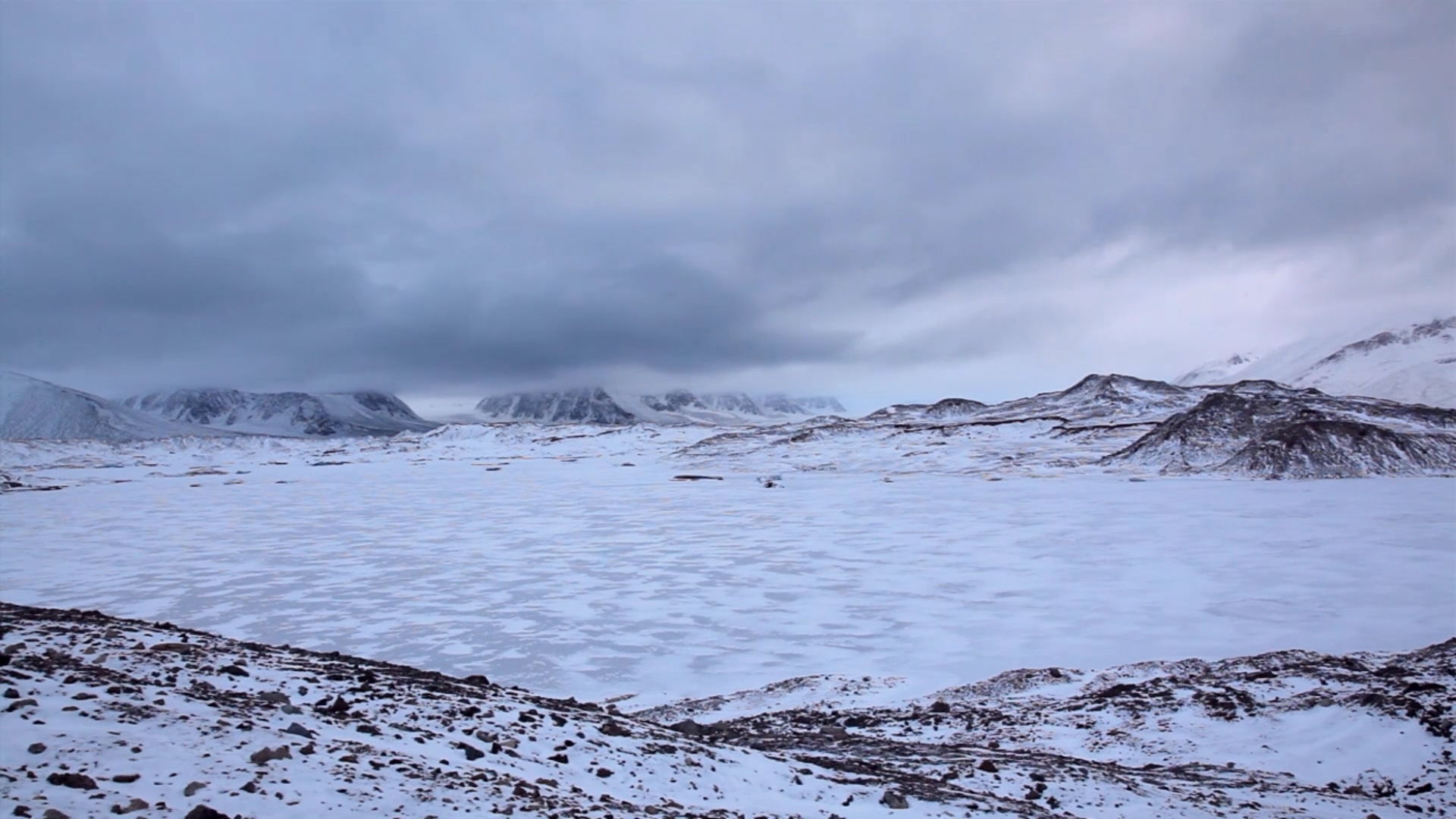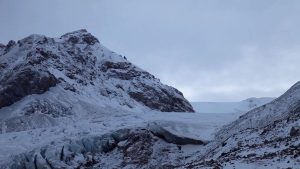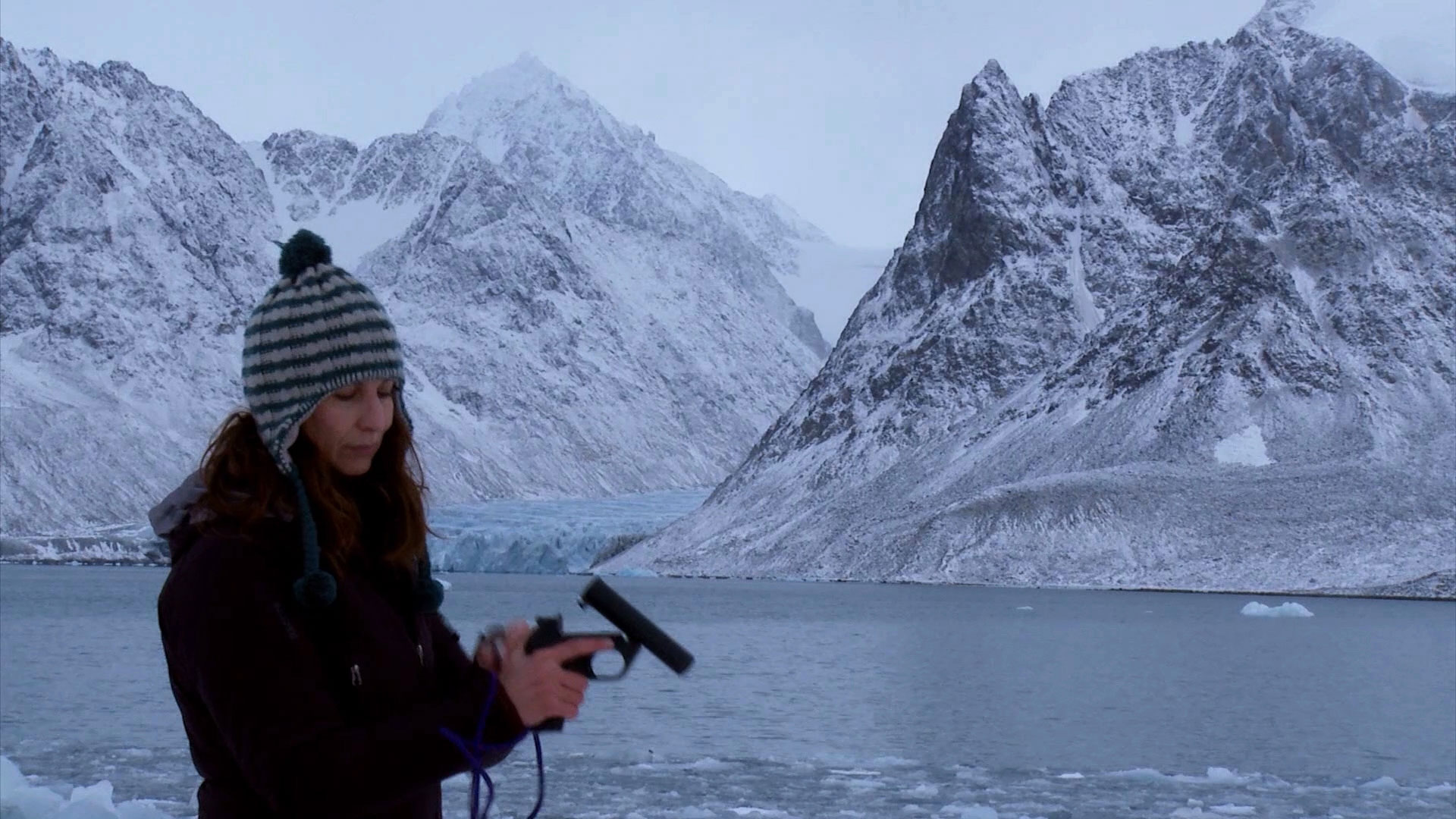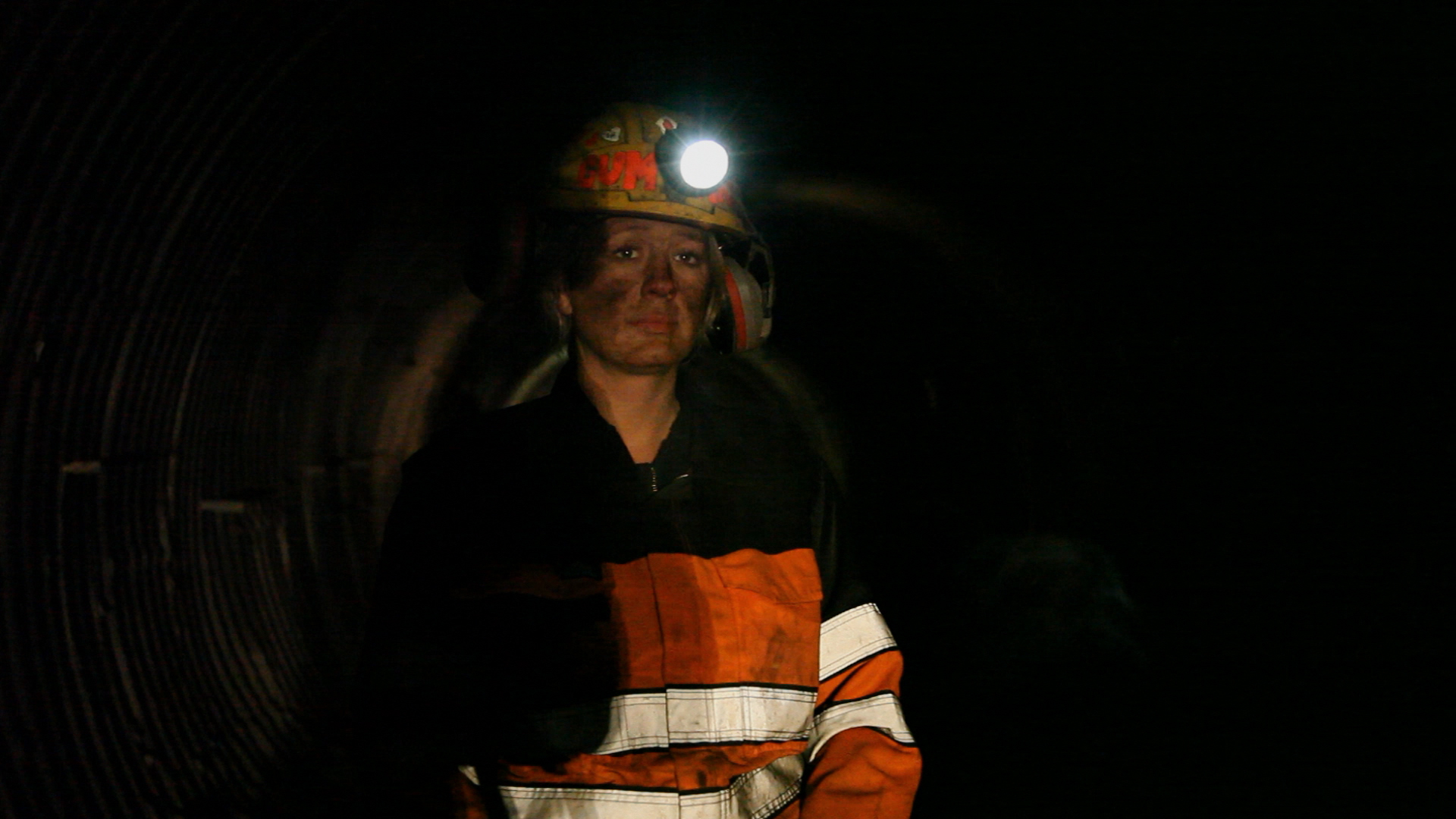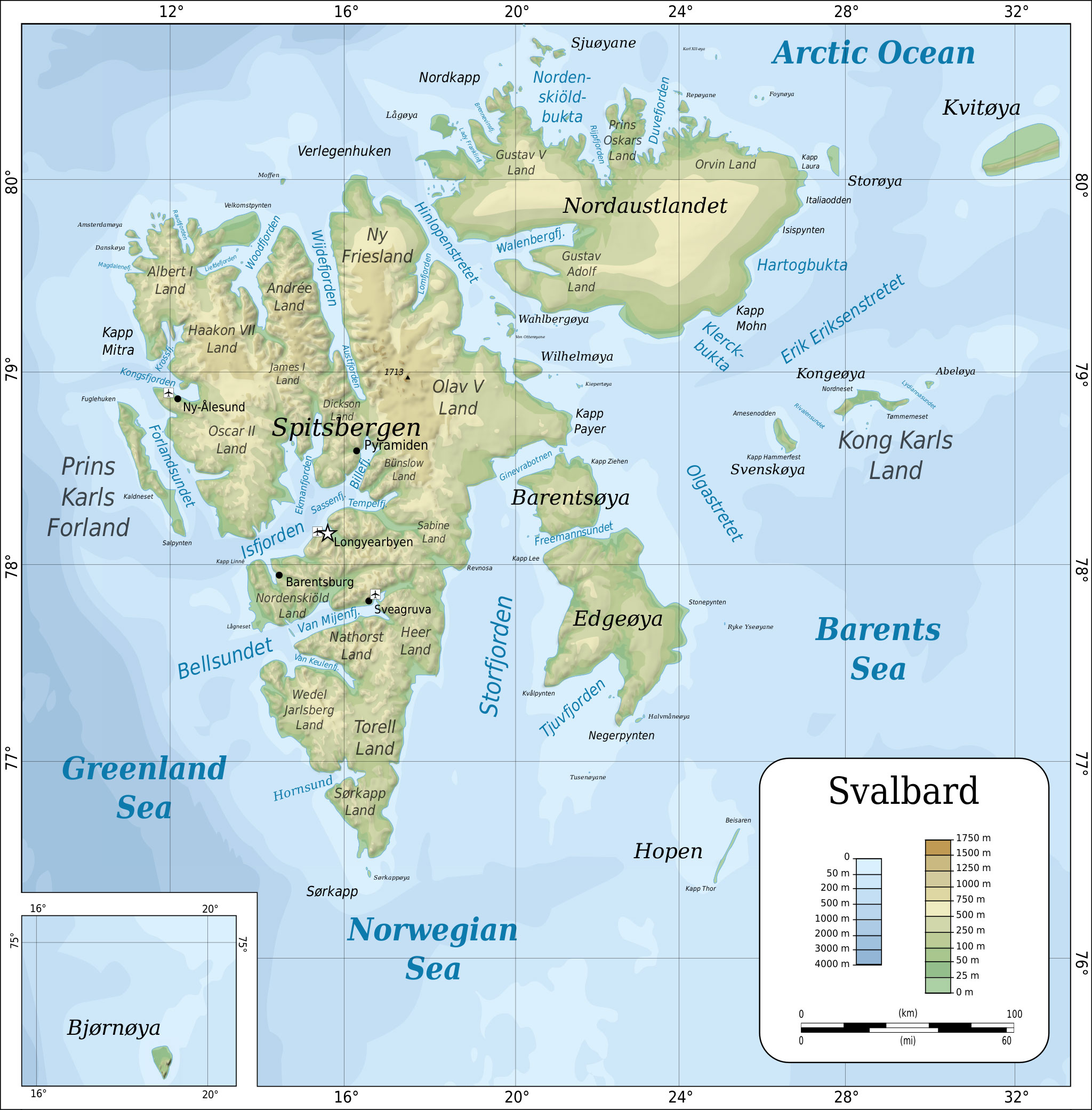
Janet Biggs: Imagination and Desire in a Northern Landscape
The Barry Lopez Foundation for Art & Environment introduces its exhibition program with an installation of three videos by Janet Biggs—Warning Shot, 2016, Brightness All Around, 2011, and Fade to White, 2010. Traveling to the high Arctic with a group of artists and scientists aboard the Noorderlict, a two-masted schooner build in 1910, Biggs’ compositions are a clarion call for a heroic landscape that will be completely transformed within our lifetimes. As the subject of centuries of exploration by Europe and the New World, the Arctic was once seen as indifferent to human enterprise, so vast and inhospitable as to be immune to any imposition. But the mining and fossil fuel industries established a firm hold in the twentieth century, and climate change is now projected to leave Arctic summers ice-free in as few as a dozen years.
Warning Shot – the visual ‘mission statement’ of the Barry Lopez Foundation for Art & Environment – is an alarm and an elegy. Filmed on Svalbard, a Norwegian archipelago halfway between Europe and the North Pole, it memorializes a simple performative act in a vast landscape with no witnesses. Silhouetted against the surrounding mountains, a solitary figure enters the frame and fires a flare toward the horizon. Her gesture is elegant, somber, and heartbreaking, lamenting what will be lost but also refusing to surrender hope, even under the most desperate of circumstances.
Brightness All Around was also filmed on Svalbard, at the Sveagruva coal mine. Quickly unseating our expectations about the Arctic as a pristine wilderness, it follows Linda Norberg, a female coal miner, as she begins her day by descending miles beneath the frozen surface. Besieged by deafening machinery and relying on a headlamp for illumination, she works in freezing temperatures and suffocating darkness. Serving as a counterpoint to the mechanical commotion of the mine is a vocal performance by New York music guru Bill Coleman, whose presence feels as menacing as Norberg’s surroundings. Singing lyrics taken from near-death experiences, Coleman becomes a witness to our struggle to survive under the most challenging circumstances. His performance is every bit a shock to the system as the Sveagruva mine, a jarring imposition that shatters the mythology of an uninhabited Arctic, reminding us that even thousands of miles away, our footprint sits heavily upon the land.
Fade to White examines our impetus to explore and claim remote territory. Following Audun Tholfsen, a member of the Noorderlict’s crew, as he paddles a solo kayak toward a featureless horizon, the video is laden with implicit danger. Biggs’ own will and endurance were tested during the voyage, and the tension in Fade to White captures the struggle to maintain balance and purpose in a landscape so vast it challenges not only one’s physical survival but their sense of individuality and identity. Fade to White also undoes the myth of the solitary white male explorer. Biggs explains, “The desire to hold onto the notion of the ‘great white north’ as a blank space awaiting our interpretation only reinforces the idea of the colonial polar hero. The ‘virgin’ north has now been mapped, surveyed, and mined, but increased knowledge has not replaced endless fantasies of discovery.” Tholfsen’s excursion is balanced with footage of countertenor John Kelly, whose androgyny and mournful voice parallel the vanishing Arctic landscape and our waning dominance over the land.
Excerpt from Warning Shot
Excerpt from Brightness All Around
Excerpt from Fade to White
Interview with Janet Biggs, The Explorer’s Club, New York City, September 2021
About the Exhibition
Janet Biggs: Imagination and Desire in a Northern Landscape takes its name from the subtitle of Arctic Dreams, Barry Lopez’s magisterial 1986 account of the human and natural history of the Arctic. Two decades later, Janet Biggs traveled to the Norwegian archipelago of Svalbard with a crew of artists and scientists aboard the Noorderlict, a two-masted schooner built in 1910. From footage compiled on two voyages in 2009 and 2010, she created Warning Shot, 2016; Brightness All Around, 2011; and Fade to White, 2010. The subject of centuries of exploration by Europe and the New World, the Arctic was once thought so vast and inhospitable, so indifferent to our presence, as to be immune to the effects of human enterprise. But climate change is now expected to leave Arctic summers ice-free as early as the next decade, and Svalbard, located halfway between Europe and the North Pole, finds itself at the epicenter of this transformation.
Although its current economy relies heavily on tourism, Svalbard was a base for Dutch, English, and Russian whalers for hundreds of years before pivoting to coal mining in the early twentieth century. Today, Svalbard is warming twice as fast as the rest of the Arctic and seven times more quickly than the global average. A recent article in the New York Times noted, “Svalbard, though seemingly timeless, is perhaps the closest thing we have to a ticking clock. …Unfortunately, climate change all but guarantees an eventual (and probably fairly imminent) collapse of what is, in fact, an exceptionally fragile ecosystem.”1 Perhaps no other place that has figured as firmly in our imagination as the Arctic will disappear as quickly and with such overwhelming consequences, with so few people having witnessed it in person. In these three works, we stand alongside Janet Biggs as she explores ideas of grief, destruction, hope, and beauty in a heroic landscape set to vanish within our lifetimes.
Warning Shot is the visual ‘mission statement’ of the Barry Lopez Foundation for Art & Environment. A graceful, somber elegy, it memorializes a simple act performed in a remote landscape with no witnesses. Silhouetted against a halo of mountains, Biggs walks onto the ice of a frozen inlet and pauses to fire a signal flare toward the horizon. The flare’s bright, arcing trajectory is a lament, a question mark as it slowly falls back to earth—what will come next, knowing we can’t depend on the appearance of a rescue? Can it be more than an act of desperation to signal for help, even if there is little chance our call will be heard? Is there room for hope when facing insurmountable circumstances? Shortly before his passing in December 2020, Barry Lopez warned, “An Era of Emergencies is bearing down on us.” Terribly aware of the limitations he was facing, and those we have placed upon ourselves, he wrote, “…we continue to believe in deliverance. …I’m compelled to say that I see no sign of such a salvation on the horizon.”2 Lopez and Biggs ask us to consider what – if anything – we are willing to do, where might we yield, if for no reason other than our own survival?
Brightness All Around was filmed at the Sveagruva coal mine, established in 1916 and eventually expanding to become Europe’s largest longwall mine. Trading on the tension between imagination and reality, our expectations of the Arctic as an untouched wilderness are shattered by snow-covered piles of debris and a passing glimpse of mountains framed by the mouth of the mine. Brightness All Around follows Linda Norberg, the only woman on a crew of 3,000 miners, as she descends miles beneath the surface to begin her shift. Surrounded by deafening machinery, she bolts a newly excavated cave ceiling into place in freezing temperatures and suffocating darkness, punctuated by the beam of her headlamp and the lights of heavy equipment that threatens from every direction.
Musician Bill Coleman appears as a counterpoint to the mine’s almost extraterrestrial setting. Sexual, seductive, and aggressive, his presence feels every bit as menacing as Norberg’s surroundings, another jarring imposition to undermine the myth of a silent, uninhabited landscape. Singing lyrics drawn from survivors of near-death experiences – “I looked down and I saw myself / There was brightness all around me” – Coleman is a witness to our struggle to survive under the most demanding circumstances. Brightness All Around’s soundtrack plays an integral role in creating a sense of isolation and sensory overload — never-ending wind, the mechanized cadence of a conveyor belt, equipment howling within the mine — all while Coleman’s performance builds to a ferocious pitch within the confines of a darkened stage. Brightness All Around ends as Norberg disappears into the blinding wash of oncoming headlights, the incessant mechanical commotion an otherworldly echo of the wind scouring the surface hundreds of feet above her.
Fade to White confronts a central theme of Biggs’ work, exploring our struggle to maintain a sense of identity and individuality when challenged by physically and emotionally threatening environments. This concept is embedded in the video’s title, Fade to White, an editing technique used to evoke death or transcendence. Fade to White follows Audun Tholfsen, a member of the Noorderlict’s crew, as he explores Svalbard on foot and by kayak. There is a sense of imminent danger, recognizing how easily one could capsize or become disoriented, losing track of bearing and distance. Paddling away from the safety of the ship through ice-filled waters, Tholfsen begins to gather speed as he heads toward a vanishing, featureless horizon — a literal fade to white. Biggs also challenges the myth of the invincible polar hero and our endless fantasies of exploration and discovery. As in Brightness All Around, she intersperses footage from Svalbard with a vocal performance, here by countertenor John Kelly singing Amarilli, Mia Bella, a solo madrigal written in 1602 by Guilio Caccini. Kelly’s mournful voice and slight physique parallels the fragility of the Arctic landscape and the catastrophic results of our hunger for adventure, territory, and profit.
Throughout her career, Janet Biggs has explored how our surroundings shape our sense of both self-awareness and self-preservation. Barry Lopez posed many of the same questions, writing in Arctic Dreams, “To inquire into the intricacies of a distant landscape, then, is to provoke thoughts about one’s own interior landscape, and the familiar landscapes of memory. The land urges us to come around to an understanding of ourselves.”3 As we face an ominous and foreboding future, the Arctic has become a mirror of our own undoing, and in these three transcendent compositions Janet Biggs describes the mechanisms of our collapse and the recognition of our fate. And yet, even when confronted by our inaction in the face of certain catastrophe, she has refused to abandon her belief in the human capacity for hope and our ability to recognize and respond to beauty. Perhaps seeing ourselves reflected in the world around us, both in places we know and in those we have only imagined, we will be able to find solace, gather strength, and plot a course forward.
- Marcus Westburg, “Bearing Witness to Svalbard’s Fragile Splendor,” The New York Times (December 6, 2021): https://www.nytimes.com/2021/12/06/travel/svalbard-climate-change-tourism.html
- Barry Lopez, “An Era of Emergencies is Upon Us and We Cannot Look Away,” lithub.com (December 24, 2020): https://lithub.com/barry-lopez-an-era-of-emergencies-is-upon-us-and-we-cannot-look-away/
- Barry Lopez, Arctic Dreams: Imagination and Desire in a Northern Landscape (New York: Charles Scribner’s Sons, 1986): 247.
About the Artist

Photo © Katja Aljert
Janet Biggs was born in Harrisburg, PA, in 1959 and lives in Brooklyn, NY. She received her BFA from Moore College of Art, Philadelphia, and pursued graduate study at the Rhode Island School of Design. Biggs is recognized for her work in video, photography, and performance, which has been seen in hundreds of screenings, site-specific installations, and live performances around the world. Focusing on individuals in extreme landscapes or situations, her work navigates the territory between art and science, including capturing kayakers performing a synchronized ballet in Arctic waters, sulfur miners at work inside an active volcano, and scientists isolated in the Mars Desert Research Station. She has collaborated with Arctic explorers, neuroscientists, aerospace engineers, astrophysicists, Yemeni refugees, a gospel choir, and a robot.
In 2012, the Tampa Museum of Art published No Limits: Janet Biggs to accompany a mid-career survey of her work. Biggs has been awarded numerous grants and residencies, including La Napoule Art Foundation Riviera Residency; The Arctic Circle—High Arctic Expedition Residency, 2009 and 2010; Art Matters: Artist’s Project Grant; New York State Council on the Arts Grant; Anonymous Was a Woman Foundation Award; National Endowment for the Arts Painting Fellowship; and, in 2018, a John Simon Guggenheim Memorial Foundation Fellowship.
About Svalbard – Other Resources
Warning Shot, Brightness All Around, and Fade to White were filmed on Svalbard, an archipelago in the Arctic Ocean located mid-way between Norway and the North Pole. Spitsbergen, the largest of nine main islands, has an area of 24,000 square miles, about the size of West Virginia. Svalbard’s population numbers under 3,000 people, concentrated on Spitsbergen in the town of Longyearbyen, the world’s northernmost year-round settlement.
The islands are believed to have first been discovered by Norse explorers in 1194, and were later settled by Dutch and English whalers at the turn of the seventeenth century. French, Danish, and Norwegian whalers followed, with Russian trappers and whalers arriving in the early eighteenth century. As whaling declined, Svalbard’s economy pivoted towards coal mining, with claims made by American, British, Dutch, Norwegian, Swedish, and Russian interests. In 1920, The Svalbard Treaty granted Norway sovereignty over the islands while dividing mineral rights among several other nations; five years later, Svalbard became an official part of the Kingdom of Norway.
Most settlements in Svalbard trace their founding to coal mining operations. Longyearbyen was established in 1906 by Americans John Munroe Longyear and Frederick Ayer of the Arctic Coal Company, who sold their mine to the government of Norway in 1916. The town and mining complex of Sveagruva was established in 1917 by the Swedish company AB Spetsbergens and purchased by the Norwegian Store Norske in 1932, who operated the mine on and off throughout the twentieth century until its closure in 2017. The Svea Nord longwall mine, where Brightness All Around was filmed, was operated by Store Norske between 2001 and 2020, and at its peak was one of the largest longwall coal mines in Europe. Following its closure, restoration efforts began and the settlement of Sveagruva was abandoned. In addition to coal, copper, iron ore, phosphate, zinc, oil, and gas are mined in Svalbard. While Norway has limited its mining activities in part as a response to global warming, it has recently considered expanding oil exploration in the Barents Sea above the Arctic Circle.

Svalbard has been a base for polar exploration and scientific research since the eighteenth century, and its current economy is grounded in tourism and environmental research. Janet Biggs’ two voyages to Svalbard were supported by The Arctic Circle, an artist and scientist expeditionary residency program. Svalbard is also home to the Global Seed Vault. Selected for its geographic isolation, political stability, and dependably cold climate, it opened in 2008 as a back-up to the world’s food supply in the event of a global catastrophe. Paradoxically, Svalbard’s climate is now warming more rapidly than anyplace on earth, and the Seed Vault has already suffered incursions of meltwater as the temperature of the surrounding permafrost has risen dramatically. As described in the references listed below, Svalbard is among the most critically threatened Arctic environments and finds itself at a dramatic ecological tipping point.
Natural History
As a result of its severe climate and sparse soil and vegetation, Svalbard’s landscape presents a unique geologic archive. Bedrock from almost every geological period is easily visible, and extensive deposits of fossils have been unusually well preserved. Formed about 400 million years ago, the islands of Svalbard spent most of their early geologic history underwater, as sand, gravel, mud, and other minerals were deposited and compressed into bedrock. Faulting and folding of the earth’s tectonic plates created dramatic mountain chains and granite peaks, while warmer intermittent climates allowed swamps to form. As layer after layer of sediment was deposited on the islands, the weight of these deposits created immense pressure and high temperatures, compressing organic and geologic matter into coal, oil, and gas. Over the last two million years, advancing and retreating ice sheets carved away upper layers of rock to reveal these coal deposits, close to the surface and easily accessible for mining.
Characterized by its mountainous topography and dramatic coastlines, Svalbard’s climate is governed by cold air and water from northern polar regions, offset by warmer air and water flowing from the south. Temperatures range from 60°F in the summer to -40°F in the winter, and the North Atlantic Current flows along Spitsbergen’s coast, providing an open channel for navigation most of the year. Glaciers cover about 60% of Svalbard’s surface, the remainder rock or thin Arctic soil. Still, the varied landscape features permanent snowfields, glacial valleys, barren plateaus, canyons, deep fjords, tundra, wetlands, lagoons, and coastal cliffs. Over 65% of Svalbard is managed as protected wilderness, including national parks and nature preserves.
In spite of its isolation and harsh climate, Svalbard is home to a relatively diverse array of flora and fauna. Three Arctic bioclimatic zones are represented among the islands, including the middle-arctic tundra zone, the northern arctic tundra zone, and the arctic polar desert. Plant cover is spare, but numbers over 1000 species including lichens, mosses, and grasses, as well as the low-lying polar willow and dwarf birch. Large populations of Arctic fox and Svalbard reindeer live on the islands, and marine mammals including polar bears, seals, walruses, and whales inhabit its surrounding waters, along with fisheries of Arctic cod and Greenland halibut. Arctic char, the only species of freshwater fish, are found in Svalbard’s glacial lakes and rivers. Svalbard’s coastal cliffs are home to numerous seabird colonies and an important breeding ground for dozens of species.
Other Resources
Culture, Natural History and Geology:
Norwegian Polar Institute: https://www.npolar.no/
Geology: https://www.npolar.no/en/themes/the-geology-of-svalbard/
Fauna: https://www.npolar.no/en/themes/fauna-svalbard/#Land-based_fauna
Vegetation: https://www.npolar.no/en/themes/vegetation-svalbard/#toggle-id-1
Wildlife: https://www.npolar.no/arter-arkiv/?q=&polar_distribution=arctic
Marginal Ice Zone: https://www.npolar.no/en/themes/the-marginal-ice-zone/
The Norwegian Biodiversity Information Centre: https://www.biodiversity.no/
Norwegian Directorate for Nature Management, Protected areas in Svalbard – securing internationally valuable cultural and natural heritage: https://en.visitsvalbard.com/dbimgs/Eng_brosj_SvalbardProtectedareas.pdf
Svalbard Museum – Cultural and Natural History Museum of Svalbard: https://svalbardmuseum.no/en
University of Oslo Natural History Museum: https://www.nhm.uio.no/english/
Taymour Soomro, “A Journey Into Norway’s Endless Night,” The New York Times Magazine, May 10, 2023: https://www.nytimes.com/2023/05/10/t-magazine/norway-svalbard-travel-darkness.html
Marcus Westbert, “Bearing Witness to Svalbard’s Fragile Splendor,” The New York Times, December 6, 2021: https://www.nytimes.com/2021/12/06/travel/svalbard-climate-change-tourism.html
Svalbard Global Seed Vault:
https://www.seedvault.no/
https://www.croptrust.org/work/svalbard-global-seed-vault/
Climate Change and Svalbard:
Damian Carrington, “Too Late Now to Save Arctic Summer Ice, Climate Scientists Find,” The Guardian, June 6, 2023: https://www.theguardian.com/environment/2023/jun/06/too-late-now-to-save-arctic-summer-ice-climate-scientists-find
Henry Fountain, “A Shift to the Not-So-Frozen North Is Well Underway, Scientists Warn,” The New York Times, December 8, 2020: https://www.nytimes.com/2020/12/08/climate/arctic-climate-change.html
Henry Fountain, “Arctic’s ‘Last Ice Area’ May Be Less Resistant to Global Warming,” The New York Times, July 1, 2021: https://www.nytimes.com/2021/07/01/climate/arctic-sea-ice-climate-change.html
Henry Fountain, “Arctic Warming Is Happening Faster Than Described, Analysis Shows,” The New York Times, August 11, 2022: https://www.nytimes.com/2022/08/11/climate/arctic-global-warming.html
Elin Vinje Jenssen, “Old aerial photos tell the grim history of the Svalbard glaciers:” Norwegian Polar Institute, January 29, 2022: https://www.npolar.no/nyhet/gamle-flybilder-forteller-svalbard-breenes-dystre-historie/
Anumita Kaur and Chris Mooney, “Arctic may have summers with no sea ice sooner than projected, study finds,” The Washington Post, June 6, 2023: https://www.washingtonpost.com/climate-environment/2023/06/06/arctic-sea-ice-melting/
Tone Sutterud and Elisabeth Ulven, “Norway Plans to Drill for Oil in Untouched Arctic Areas,” The Guardian, August 26, 2020: https://www.theguardian.com/environment/2020/aug/26/norway-plans-to-drill-for-oil-in-untouched-arctic-areas-svalbard
Raymond Zhong, “Trends in Arctic Report Card: ‘Consistent, Alarming and Undeniable,’” The New York Times, December 14, 2021: https://www.nytimes.com/2021/12/14/climate/arctic-report-card-climate-change.html
Raymon Zhong, “A Trove of Old Photos Could Reveal the Future of These Arctic Glaciers, The New York Times, January 19, 2022: https://www.nytimes.com/2022/01/19/climate/svalbard-glacier-melting.html
Raymond Zhong, “Arctic Summer Could Be Practically Sea-Ice-Free by the 2030s,” The New York Times, June 6, 2023: https://www.nytimes.com/2023/06/06/climate/arctic-sea-ice-melting.html
Tour Schedule/Availability
AVAILABLE 2024–2026
Janet Biggs: Imagination and Desire in a Northern Landscape is available to six venues through 2024. Please contact us at exhibitions@barrylopezfoundation.org for further information or if you are interested in being an exhibition venue.
September 15 – December 15, 2023
Berman Museum of Art
Ursinus College
Collegeville, PA
February 10 – May 12, 2024
Everson Museum of Art
Syracuse, NY
January 21 – March 21, 2025
Blue Galleries
Boise State University
Boise, ID

